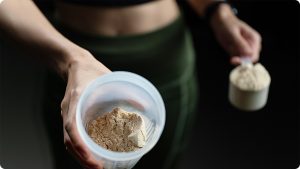Everyone knows about whey protein – it’s what most of us have if supplementing, and it’s been a staple of sports diets for ages. But fewer people have heard about casein – whey’s brother of sorts. Casein is another protein that exists in milk. However, it is different from whey in how our body reacts to it. In this post, we’ll explore what makes casein so different from whey, where you can get it from and how to use it to reach your goals.
What is casein?
Milk contains many different nutrients – it’s full of fats, sugars, and, of course, protein. 80% of the protein in milk is casein protein, and its role is to help carry calcium and phosphate. It is a complete protein containing all amino acids.
There are four types of casein proteins in cow milk. Casein proteins in milk form small spherical aggregates, which allow them to carry calcium while keeping milk in the form of an emulsion. Three types of casein, casein αS1-, αS2-, and β-caseins, are the ones responsible for holding onto calcium. The other type of casein interacts with whey proteins and other micelles. It ensures that all of them don’t clump together. This helps keep the milk liquid.
Casein is, therefore, another milk protein, but what makes it different from whey is that it exists in micelles and can hold onto calcium.
Uses of casein
There are multiple uses for casein, most of which relate to muscle synthesis and body composition:
- Supports muscle growth. Casein is a protein that contributes amino acids that can help you grow muscle. Digesting takes a while, making it an excellent option for long-term feeding of muscle mass. That’s why many people take casein supplements before bed, to keep muscle growth going overnight. Whey and casein seem to be equally effective at supporting muscle growth.
- Preserves lean muscle. Protein supports the preservation of muscle mass when we’re trying to lose weight. Therefore, many people use casein protein for weight loss.
- Support recovery. Long-lasting amino acid release can help lower damage to muscles after a workout. Therefore, it may assist with muscle soreness.
Food sources of casein
Casein is a naturally occurring protein in different foods. We can find casein in milk. This also means that any dairy or milk-containing products can contain casein. So, good sources of casein include:
- Yoghurt, like Greek or natural yoghurt
- Butter and butter products like margarine and ghee
- Cheese and cheese products
- Ice creams, dairy desserts, kefir, cream
- Any product that contains milk powder
Therefore, dairy can be a good way to go if you’d like to get plenty of casein protein. However, if you’re not a massive fan of dairy products, there are other options. The easiest way to get casein is through casein protein powder.
Casein supplements
Casein supplements can come in multiple forms, so if you’re trying to choose the best casein protein, you need to keep some things in mind.
If you’re looking for casein supplements, they can take on multiple forms:
- Micellar casein. This is the most common and natural form of casein. It clumps together in the gut, which promotes long-term amino acid release.
- Casein hydrolysate. A pre-digested form of casein, this supplement is absorbed quicker than micellar casein.
- Casein blends. Some supplements have multiple types of protein together in one, like Maxler Golden 7 Protein Blend. These usually have quick-acting amino acids and slow-release casein for lengthy muscle support.
How to take a casein supplement?
Casein supplements are straightforward to use. They are just like any other protein powder. The most popular way to use them is by making casein protein shakes. These serve as a great snack or simply an additional protein boost throughout the day.
Casein can also be used for cooking, so you can add it to yoghurts, smoothies, and even healthy baked goods for an extra bit of protein.
Casein is also known for its long-lasting feeding of muscle tissue. Therefore, many prefer to take casein before bed to support muscle-building through the night. To do so, make a casein protein shake and drink it 30 minutes before going to bed. Usually, a larger serving of casein protein usually works better, so use 40 grams of casein per shake.
How much casein should I take?
Casein usage is very similar to any other protein powder. It can be used to meet your daily protein goals or as a high-protein snack. Therefore, how much you take and how frequently you do so will change according to your needs.
Servings of 20-40 grams are typically enough. For those who take casein for overnight muscle-building support, dosages closer to 40g are more effective. However, the overall quantity and frequency of supplementation will vary with your goals. That’s why, for most people, reaching out to a professional can be helpful.
Remember that casein alone can’t be a replacement for a healthy and nutritious diet. Therefore, look at using it as an addition to your routine rather than a replacement for a healthy meal.
What are the side effects of casein?
Are there any side effects to casein? For most people, this protein is safe.
One of the most important things to keep in mind about casein’s side effects is that some people may be allergic to casein. In this case, casein protein powders or casein-containing products should be avoided. However, if you don’t have a casein allergy, you’re free to enjoy this protein.
Casein protein can be a great addition to anyone’s routine. Whether you’d like to build muscle, shed pounds, or even just look after your skeletal health, casein can be a great choice. Pair it with a balanced and healthy diet, as well as an active lifestyle, for the best results. You’re on a path to a better you – use casein to your advantage!








